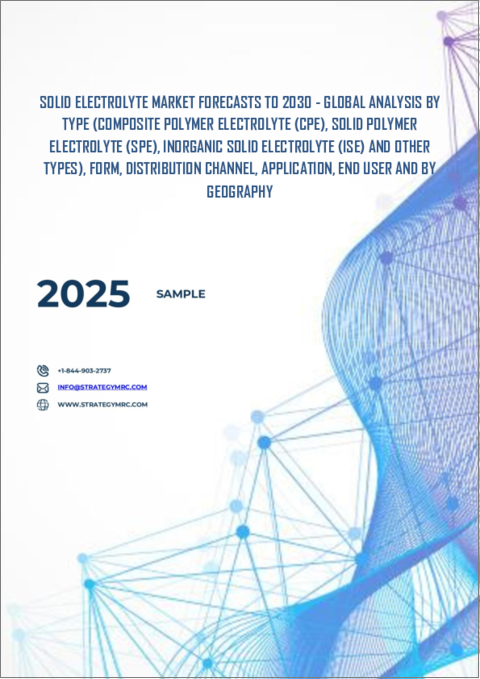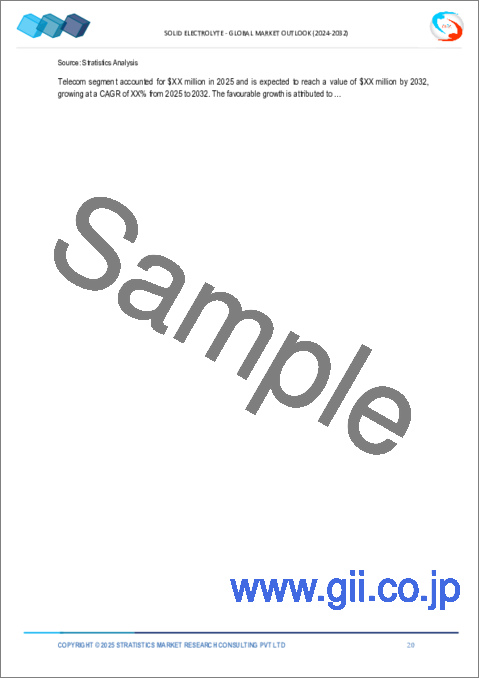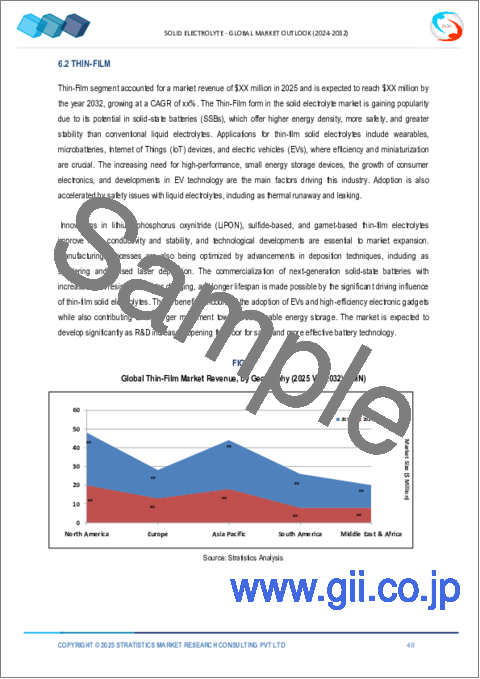|
|
市場調査レポート
商品コード
1558275
固体電解質市場の2030年までの予測:タイプ、形態、流通チャネル、用途、エンドユーザー、地域別の世界分析Solid Electrolyte Market Forecasts to 2030 - Global Analysis By Type (Composite Polymer Electrolyte, Solid Polymer Electrolyte, Inorganic Solid Electrolyte and Other Types), Form, Distribution Channel, Application, End User and By Geography |
||||||
カスタマイズ可能
|
|||||||
| 固体電解質市場の2030年までの予測:タイプ、形態、流通チャネル、用途、エンドユーザー、地域別の世界分析 |
|
出版日: 2024年09月06日
発行: Stratistics Market Research Consulting
ページ情報: 英文 200+ Pages
納期: 2~3営業日
|
全表示
- 概要
- 図表
- 目次
Stratistics MRCによると、世界の固体電解質市場は2024年に3,050万米ドルを占め、2030年には6,810万米ドルに達すると予測され、予測期間中のCAGRは14.3%です。
固体電解質は、電池やその他の電気化学デバイスに使用される電解質材料の一種で、イオンは液体ではなく固相を移動します。固体電解質は、電子的に絶縁性を保ちながらイオンを伝導し、液体電解質に代わるより安全で安定した電解質を提供します。固体電解質は、エネルギー密度が高く、安全性が向上し、寿命が長い全固体電池の開発に不可欠です。
高エネルギー密度貯蔵システムに対する需要の増加
高エネルギー密度貯蔵システムへの需要の高まりが、市場の大きな成長を促しています。固体電解質は、従来の液体電解質電池に比べて優れたエネルギー密度を提供する高度な全固体電池の開発を可能にします。これらの電池は、コンパクトで高性能なエネルギー貯蔵ソリューションを必要とするアプリケーションに最適です。より効率的で長寿命のエネルギー貯蔵への要求が強まるにつれ、固体電解質は、こうした進化するニーズに応えるための重要な要素として浮上しています。
水素生成インフラの不足
水素生成のためのインフラの欠如は、水素燃料電池の普及を制限することにより、市場に悪影響を及ぼします。水素製造と流通のための十分なインフラがなければ、固体電解質をベースとする技術の展開は妨げられます。この制限により、市場の成長が鈍化し、投資機会が減少し、エネルギー貯蔵ソリューションの進歩が遅れ、最終的には、よりクリーンで持続可能なエネルギーシステムへの移行が阻害されます。
高性能電池材料への需要の急増
液体電解質よりも導電性と安定性に優れた固体電解質は、電池の効率、安全性、エネルギー密度の向上を目指す企業にますます好まれるようになっています。この動向は、電気自動車、家電製品、再生可能エネルギーシステムにおける高度なエネルギー貯蔵ソリューションの必要性に後押しされています。その結果、固体電解質の市場は急速に拡大し、進化する性能要求に対応するための投資と技術革新を引き寄せています。
費用対効果と製造のスケーラビリティにおける課題
高い製造コストと複雑な製造工程により、固体電解質は従来の代替品よりも高価になり、その普及を制限しています。また、これらの課題は生産規模の拡大も遅らせ、増大する市場需要に対応する能力を制限しています。その結果、高コストと限られた製造拡張性が固体電解質技術の成長を妨げ、競争力に影響を与え、エネルギー貯蔵ソリューションの進歩が遅れることになります。
COVID-19の影響:
COVID-19の大流行は、サプライチェーンを混乱させ、生産を遅らせ、研究開発活動に影響を与えることで、市場に大きな影響を与えました。操業停止や規制により原材料が不足し、製造工程に遅れが生じました。さらに、経済の先行き不透明感から新技術への投資が減少し、先進エネルギー貯蔵ソリューションの採用が遅れました。こうした課題にもかかわらず、パンデミックは回復力のある持続可能なエネルギーシステムへの関心を加速させ、復興が進むにつれて固体電解質セクターの将来の成長を促進する可能性もあります。
予測期間中、電気自動車用電池分野が最大になる見込み
予測期間中、電気自動車用電池が最大となる見込み。固体電解質は、より高いエネルギー密度、改善された熱安定性、漏出や燃焼のリスクの低減を提供することにより、電気自動車用電池の性能と安全性を向上させる。これらの特性は、信頼性が高く効率的なエネルギー貯蔵ソリューションが求められる電気自動車の進歩にとって極めて重要です。EV市場の拡大に伴い、バッテリーへの固体電解質の採用が増加し、技術革新が促進され、この分野の市場成長が促進されると予想されます。
予測期間中、民生用電子機器分野のCAGRが最も高くなる見込み
予測期間中、CAGRが最も高くなると予想されるのは民生用電子機器分野です。固体電解質は電池の安全性、エネルギー密度、寿命を向上させるため、スマートフォン、タブレット、ウェアラブルなどの次世代家電の電源として理想的です。より小型で効率的なデバイスを求める動きが、固体電解質技術の採用を後押ししており、電池寿命の延長と性能の向上が期待されています。この動向は、固体電解質をコンシューマー・エレクトロニクスの進歩における重要なコンポーネントとして位置づけています。
最大のシェアを占める地域:
北米は、高性能エネルギー貯蔵ソリューションの需要増加に牽引され、予測期間中最大の市場シェアを占めると予測されます。この地域は、電気自動車、再生可能エネルギー、ポータブル電子機器に注力しており、安全性、エネルギー密度、寿命が向上した固体電解質の採用を後押ししています。さらに、この地域の強力な研究開発インフラとクリーンエネルギー技術への多額の投資が、技術革新と市場拡大を加速しています。
CAGRが最も高い地域:
アジア太平洋地域は、電気自動車(EV)セクターの急拡大と先進バッテリー技術への投資の増加により、予測期間中に最も高いCAGRを記録すると予測されます。この地域は人口が多く、より安全で高性能な電池に対する需要が高まっているため、固体電解質はエネルギー密度の向上や安定性といった利点を提供し、次世代のエネルギー貯蔵ソリューションに最適であるため、市場はさらに推進されます。
無料カスタマイズサービス:
本レポートをご購読のお客様には、以下の無料カスタマイズオプションのいずれかをご利用いただけます:
- 企業プロファイル
- 追加市場プレーヤーの包括的プロファイリング(3社まで)
- 主要企業のSWOT分析(3社まで)
- 地域セグメンテーション
- 顧客の関心に応じた主要国の市場推計・予測・CAGR(注:フィージビリティチェックによる)
- 競合ベンチマーキング
- 製品ポートフォリオ、地理的プレゼンス、戦略的提携に基づく主要企業のベンチマーキング
目次
第1章 エグゼクティブサマリー
第2章 序文
- 概要
- ステークホルダー
- 調査範囲
- 調査手法
- データマイニング
- データ分析
- データ検証
- 調査アプローチd
- 調査情報源
- 1次調査情報源
- 2次調査情報源
- 前提条件
第3章 市場動向分析
- 促進要因
- 抑制要因
- 機会
- 脅威
- 製品分析
- 用途分析
- エンドユーザー分析
- 新興市場
- COVID-19の影響
第4章 ポーターのファイブフォース分析
- 供給企業の交渉力
- 買い手の交渉力
- 代替品の脅威
- 新規参入業者の脅威
- 競争企業間の敵対関係
第5章 世界の固体電解質市場:タイプ別
- 複合ポリマー電解質(CPE)
- 固体高分子電解質(SPE)
- 無機固体電解質(ISE)
- その他のタイプ
第6章 世界の固体電解質市場:形態別
- 薄膜
- バルク
第7章 世界の固体電解質市場:流通チャネル別
- 直接販売
- オンライン販売
- 小売チャネル
第8章 世界の固体電解質市場:用途別
- 電気自動車用バッテリー
- エネルギーハーベスティング
- 医療機器
- ワイヤレスセンサー
- その他の用途
第9章 世界の固体電解質市場:エンドユーザー別
- 通信
- 自動車
- 家電
- 航空宇宙および防衛
- その他のエンドユーザー
第10章 世界の固体電解質市場:地域別
- 北米
- 米国
- カナダ
- メキシコ
- 欧州
- ドイツ
- 英国
- イタリア
- フランス
- スペイン
- その他欧州
- アジア太平洋
- 日本
- 中国
- インド
- オーストラリア
- ニュージーランド
- 韓国
- その他アジア太平洋地域
- 南米
- アルゼンチン
- ブラジル
- チリ
- その他南米
- 中東・アフリカ
- サウジアラビア
- アラブ首長国連邦
- カタール
- 南アフリカ
- その他中東とアフリカ
第11章 主な発展
- 契約、パートナーシップ、コラボレーション、合弁事業
- 買収と合併
- 新製品発売
- 事業拡大
- その他の主要戦略
第12章 企業プロファイリング
- Samsung SDI Co., Ltd.
- LG Chem Ltd.
- Panasonic Corporation
- Toyota Motor Corporation
- QuantumScape Corporation
- Solid Power, Inc.
- Murata Manufacturing Co., Ltd.
- Kyocera Corporation
- Ceramic Fuel Cells Limited
- Toshiba Corporation
- Nano One Materials Corp.
- 3M Company
- Brightvolt, Inc.
- Enovix Corporation
- Northvolt AB
List of Tables
- Table 1 Global Solid Electrolyte Market Outlook, By Region (2022-2030) ($MN)
- Table 2 Global Solid Electrolyte Market Outlook, By Type (2022-2030) ($MN)
- Table 3 Global Solid Electrolyte Market Outlook, By Composite Polymer Electrolyte (CPE) (2022-2030) ($MN)
- Table 4 Global Solid Electrolyte Market Outlook, By Solid Polymer Electrolyte (SPE) (2022-2030) ($MN)
- Table 5 Global Solid Electrolyte Market Outlook, By Inorganic Solid Electrolyte (ISE) (2022-2030) ($MN)
- Table 6 Global Solid Electrolyte Market Outlook, By Other Types (2022-2030) ($MN)
- Table 7 Global Solid Electrolyte Market Outlook, By Form (2022-2030) ($MN)
- Table 8 Global Solid Electrolyte Market Outlook, By Thin-Film (2022-2030) ($MN)
- Table 9 Global Solid Electrolyte Market Outlook, By Bulk (2022-2030) ($MN)
- Table 10 Global Solid Electrolyte Market Outlook, By Distribution Channel (2022-2030) ($MN)
- Table 11 Global Solid Electrolyte Market Outlook, By Direct Sales (2022-2030) ($MN)
- Table 12 Global Solid Electrolyte Market Outlook, By Online Sales (2022-2030) ($MN)
- Table 13 Global Solid Electrolyte Market Outlook, By Retail Channels (2022-2030) ($MN)
- Table 14 Global Solid Electrolyte Market Outlook, By Application (2022-2030) ($MN)
- Table 15 Global Solid Electrolyte Market Outlook, By Electric Vehicle Batteries (2022-2030) ($MN)
- Table 16 Global Solid Electrolyte Market Outlook, By Energy Harvesting (2022-2030) ($MN)
- Table 17 Global Solid Electrolyte Market Outlook, By Medical Devices (2022-2030) ($MN)
- Table 18 Global Solid Electrolyte Market Outlook, By Wireless Sensors (2022-2030) ($MN)
- Table 19 Global Solid Electrolyte Market Outlook, By Other Applications (2022-2030) ($MN)
- Table 20 Global Solid Electrolyte Market Outlook, By End User (2022-2030) ($MN)
- Table 21 Global Solid Electrolyte Market Outlook, By Telecom (2022-2030) ($MN)
- Table 22 Global Solid Electrolyte Market Outlook, By Automotive (2022-2030) ($MN)
- Table 23 Global Solid Electrolyte Market Outlook, By Consumer Electronics (2022-2030) ($MN)
- Table 24 Global Solid Electrolyte Market Outlook, By Aerospace & Defense (2022-2030) ($MN)
- Table 25 Global Solid Electrolyte Market Outlook, By Other End Users (2022-2030) ($MN)
Note: Tables for North America, Europe, APAC, South America, and Middle East & Africa Regions are also represented in the same manner as above.
According to Stratistics MRC, the Global Solid Electrolyte Market is accounted for $30.5 million in 2024 and is expected to reach $68.1 million by 2030 growing at a CAGR of 14.3% during the forecast period. A solid electrolyte is a type of electrolyte material used in batteries and other electrochemical devices, where ions move through a solid phase rather than a liquid. It conducts ions while remaining electronically insulating, providing a safer, more stable alternative to liquid electrolytes. Solid electrolytes are crucial for the development of all-solid-state batteries, which offer higher energy density, improved safety, and longer lifespans.
Market Dynamics:
Driver:
Increasing demand for high energy density storage systems
The increasing demand for high energy density storage systems is driving significant growth in the market. Solid electrolytes enable the development of advanced all-solid-state batteries that offer superior energy density compared to traditional liquid electrolyte batteries. These batteries are ideal for applications requiring compact, high-performance energy storage solutions. As the push for more efficient and longer-lasting energy storage intensifies, solid electrolytes are emerging as a crucial component in meeting these evolving needs.
Restraint:
Lack of infrastructure for hydrogen generation
The lack of infrastructure for hydrogen generation negatively affects the market by restricting the widespread adoption of hydrogen fuel cells. Without adequate infrastructure for hydrogen production and distribution, the deployment of solid electrolyte-based technologies is hindered. This limitation results in slower market growth, reduced investment opportunities, and delayed advancements in energy storage solutions, ultimately impeding the transition to cleaner, more sustainable energy systems.
Opportunity:
Surging demand for high performance battery materials
Solid electrolytes, which have better conductivity and stability than their liquid counterparts, are becoming more and more preferred by businesses looking to improve battery efficiency, safety, and energy density. This trend is driven by the need for advanced energy storage solutions in electric vehicles, consumer electronics, and renewable energy systems. Consequently, the market for solid electrolytes is expanding rapidly, attracting investment and innovation to meet the evolving performance demands.
Threat:
Challenges in cost-effectiveness and scalability of production
High production costs and complex manufacturing processes make solid electrolytes more expensive than traditional alternatives, limiting their widespread adoption. These challenges also slow down scaling efforts, restricting the ability to meet increasing market demands. As a result, the high cost and limited production scalability impede the growth of solid electrolyte technologies, affecting their competitiveness and slowing progress in advancing energy storage solutions.
Covid-19 Impact:
The COVID-19 pandemic significantly impacted the market by disrupting supply chains, delaying production, and affecting research and development activities. Lockdowns and restrictions led to shortages of raw materials and delays in manufacturing processes. Additionally, the economic uncertainty reduced investment in new technologies and slowed the adoption of advanced energy storage solutions. Despite these challenges, the pandemic also accelerated interest in resilient and sustainable energy systems, potentially driving future growth in the solid electrolyte sector as recovery progresses.
The electric vehicle batteries segment is expected to be the largest during the forecast period
The electric vehicle batteries is expected to be the largest during the forecast period. Solid electrolytes enhance the performance and safety of EV batteries by offering higher energy density, improved thermal stability, and reduced risk of leakage or combustion. These attributes are crucial for advancing electric vehicles, which demand reliable and efficient energy storage solutions. As the EV market expands, the adoption of solid electrolytes in batteries is expected to increase, fostering innovation and driving market growth in this sector.
The consumer electronics segment is expected to have the highest CAGR during the forecast period
The consumer electronics segment is expected to have the highest CAGR during the forecast period. Solid electrolytes enhance battery safety, energy density, and longevity, making them ideal for powering next-generation consumer electronics such as smartphones, tablets, and wearables. The push for more compact and efficient devices drives the adoption of solid electrolyte technologies, promising longer battery life and improved performance. This trend positions solid electrolytes as a key component in advancing consumer electronics.
Region with largest share:
North America is projected to hold the largest market share during the forecast period driven by increasing demand for high-performance energy storage solutions. The region's focus on electric vehicles, renewable energy, and portable electronics is boosting the adoption of solid electrolytes, which offer enhanced safety, energy density, and longevity. Moreover, the region's strong research and development infrastructure and significant investments in clean energy technologies are accelerating innovation and market expansion.
Region with highest CAGR:
Asia Pacific is projected to witness the highest CAGR over the forecast period driven by the rapid expansion of the electric vehicle (EV) sector and increasing investments in advanced battery technologies. The region's large population and rising demand for safer, high-performance batteries further propel the market, as solid electrolytes offer advantages like improved energy density and stability, making them ideal for next-generation energy storage solutions.
Key players in the market
Some of the key players in Solid Electrolyte market include Samsung SDI Co., Ltd., LG Chem Ltd., Panasonic Corporation, Toyota Motor Corporation, QuantumScape Corporation, Solid Power, Inc., Murata Manufacturing Co., Ltd., Kyocera Corporation, Ceramic Fuel Cells Limited, Toshiba Corporation, Nano One Materials Corp., 3M Company, Brightvolt, Inc., Enovix Corporation and Northvolt AB.
Key Developments:
In July 2024, Volkswagen Group's battery company PowerCo and QuantumScape announced they have entered into a groundbreaking agreement to industrialize QuantumScape's next-generation solid-state lithium-metal battery technology.
In April 2024, Factorial Inc. and LG Chem announced the signing of a memorandum of understanding (MOU) to accelerate the development of solid-state battery materials. The agreement aims to strengthen cooperation in the field of next-generation battery materials.
Types Covered:
- Composite Polymer Electrolyte (CPE)
- Solid Polymer Electrolyte (SPE)
- Inorganic Solid Electrolyte (ISE)
- Other Types
Forms Covered:
- Thin-Film
- Bulk
Distribution Channels Covered:
- Direct Sales
- Online Sales
- Retail Channels
Applications Covered:
- Electric Vehicle Batteries
- Energy Harvesting
- Medical Devices
- Wireless Sensors
- Other Applications
End Users Covered:
- Telecom
- Automotive
- Consumer Electronics
- Aerospace & Defense
- Other End Users
Regions Covered:
- North America
- US
- Canada
- Mexico
- Europe
- Germany
- UK
- Italy
- France
- Spain
- Rest of Europe
- Asia Pacific
- Japan
- China
- India
- Australia
- New Zealand
- South Korea
- Rest of Asia Pacific
- South America
- Argentina
- Brazil
- Chile
- Rest of South America
- Middle East & Africa
- Saudi Arabia
- UAE
- Qatar
- South Africa
- Rest of Middle East & Africa
What our report offers:
- Market share assessments for the regional and country-level segments
- Strategic recommendations for the new entrants
- Covers Market data for the years 2022, 2023, 2024, 2026, and 2030
- Market Trends (Drivers, Constraints, Opportunities, Threats, Challenges, Investment Opportunities, and recommendations)
- Strategic recommendations in key business segments based on the market estimations
- Competitive landscaping mapping the key common trends
- Company profiling with detailed strategies, financials, and recent developments
- Supply chain trends mapping the latest technological advancements
Free Customization Offerings:
All the customers of this report will be entitled to receive one of the following free customization options:
- Company Profiling
- Comprehensive profiling of additional market players (up to 3)
- SWOT Analysis of key players (up to 3)
- Regional Segmentation
- Market estimations, Forecasts and CAGR of any prominent country as per the client's interest (Note: Depends on feasibility check)
- Competitive Benchmarking
- Benchmarking of key players based on product portfolio, geographical presence, and strategic alliances
Table of Contents
1 Executive Summary
2 Preface
- 2.1 Abstract
- 2.2 Stake Holders
- 2.3 Research Scope
- 2.4 Research Methodology
- 2.4.1 Data Mining
- 2.4.2 Data Analysis
- 2.4.3 Data Validation
- 2.4.4 Research Approach d
- 2.5 Research Sources
- 2.5.1 Primary Research Sources
- 2.5.2 Secondary Research Sources
- 2.5.3 Assumptions
3 Market Trend Analysis
- 3.1 Introduction
- 3.2 Drivers
- 3.3 Restraints
- 3.4 Opportunities
- 3.5 Threats
- 3.6 Product Analysis
- 3.7 Application Analysis
- 3.8 End User Analysis
- 3.9 Emerging Markets
- 3.10 Impact of Covid-19
4 Porters Five Force Analysis
- 4.1 Bargaining power of suppliers
- 4.2 Bargaining power of buyers
- 4.3 Threat of substitutes
- 4.4 Threat of new entrants
- 4.5 Competitive rivalry
5 Global Solid Electrolyte Market, By Type
- 5.1 Introduction
- 5.2 Composite Polymer Electrolyte (CPE)
- 5.3 Solid Polymer Electrolyte (SPE)
- 5.4 Inorganic Solid Electrolyte (ISE)
- 5.5 Other Types
6 Global Solid Electrolyte Market, By Form
- 6.1 Introduction
- 6.2 Thin-Film
- 6.3 Bulk
7 Global Solid Electrolyte Market, By Distribution Channel
- 7.1 Introduction
- 7.2 Direct Sales
- 7.3 Online Sales
- 7.4 Retail Channels
8 Global Solid Electrolyte Market, By Application
- 8.1 Introduction
- 8.2 Electric Vehicle Batteries
- 8.3 Energy Harvesting
- 8.4 Medical Devices
- 8.5 Wireless Sensors
- 8.6 Other Applications
9 Global Solid Electrolyte Market, By End User
- 9.1 Introduction
- 9.2 Telecom
- 9.3 Automotive
- 9.4 Consumer Electronics
- 9.5 Aerospace & Defense
- 9.6 Other End Users
10 Global Solid Electrolyte Market, By Geography
- 10.1 Introduction
- 10.2 North America
- 10.2.1 US
- 10.2.2 Canada
- 10.2.3 Mexico
- 10.3 Europe
- 10.3.1 Germany
- 10.3.2 UK
- 10.3.3 Italy
- 10.3.4 France
- 10.3.5 Spain
- 10.3.6 Rest of Europe
- 10.4 Asia Pacific
- 10.4.1 Japan
- 10.4.2 China
- 10.4.3 India
- 10.4.4 Australia
- 10.4.5 New Zealand
- 10.4.6 South Korea
- 10.4.7 Rest of Asia Pacific
- 10.5 South America
- 10.5.1 Argentina
- 10.5.2 Brazil
- 10.5.3 Chile
- 10.5.4 Rest of South America
- 10.6 Middle East & Africa
- 10.6.1 Saudi Arabia
- 10.6.2 UAE
- 10.6.3 Qatar
- 10.6.4 South Africa
- 10.6.5 Rest of Middle East & Africa
11 Key Developments
- 11.1 Agreements, Partnerships, Collaborations and Joint Ventures
- 11.2 Acquisitions & Mergers
- 11.3 New Product Launch
- 11.4 Expansions
- 11.5 Other Key Strategies
12 Company Profiling
- 12.1 Samsung SDI Co., Ltd.
- 12.2 LG Chem Ltd.
- 12.3 Panasonic Corporation
- 12.4 Toyota Motor Corporation
- 12.5 QuantumScape Corporation
- 12.6 Solid Power, Inc.
- 12.7 Murata Manufacturing Co., Ltd.
- 12.8 Kyocera Corporation
- 12.9 Ceramic Fuel Cells Limited
- 12.10 Toshiba Corporation
- 12.11 Nano One Materials Corp.
- 12.12 3M Company
- 12.13 Brightvolt, Inc.
- 12.14 Enovix Corporation
- 12.15 Northvolt AB






